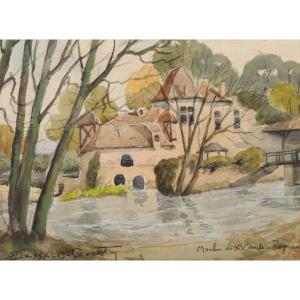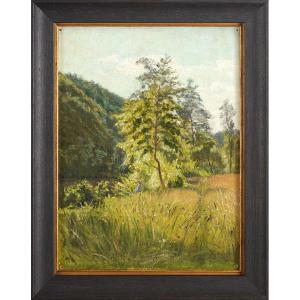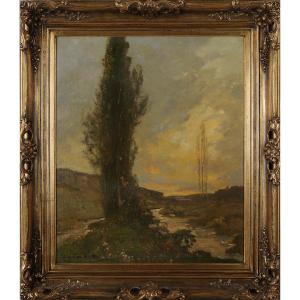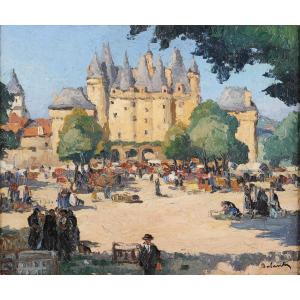(Madrid 1880 – Paris 1971)
The market at Jumilhac le Grand
Oil on canvas
H. 46 cm; L. 55 cm
Signed lower right
Descendant of a Protestant and Saintongeaise family, Gaston Balande, whose real name is Blandin, was born in Madrid on May 31, 1880, an illegitimate birth between his mother, a merchant's daughter and his father, a chef of station. All his youth, he lived in the café-restaurant of his grandparents in Saujon. This café still exists (place de la Gare). A solitary child, he took advantage of his grandparents' attic to take an interest in his passion and sketch. Gaston was 11 years old when his mother married Fernand Balande who officially recognized him. His education was short and little followed by his family. After his school certificate, he was placed as an apprentice with various employers in Saujon, then with the painter-decorator Pollard, in La Tremblade in December 1895. Recommended by the lawyer Mousset, Balande discovered painting by the Abbé Alfred Couturaud, pupil of the painter Henri Harpignies (1819-1916). In 1900, he moved to Paris and entered the competition for the School of Decorative Arts where he met the painter Harpignies, a great painter of landscapes. For several years, Balande exercised various low-paid jobs, and he took advantage of his free time to visit the museums of the capital and thus complete his artistic education. In March 1901, he passed his competition at the School of Decorative Arts. He did his military service as a nurse and was incorporated in Bordeaux, then in La Rochelle and then in Paris. Thanks to the liberal regime, he was able to continue his artistic exploration by taking painting lessons. He was discharged following a lung disease. During his convalescence, he met Claire Roux who became his wife. She accompanied him to Paris. They had a son, Gaston Paul André Balande, who followed his father's path and became a painter (so that the latter's paintings are recognized for his talent alone, he signed them under the name of Delauzières). Gaston Balande continued his small jobs and worked in the workshops of Fernand Cormon, Jean-Paul Laurens and Rupert Bunny, which allowed him to refine his training. In 1903, during an exhibition at the Salon of French Artists, he won the Edouard Lemaitre prize for his painting "Au Quai d'Orsay in winter". He finally set up his own studio in Etaples (Pas-de-Calais), where he painted during his holidays. In 1906 he obtained state encouragement and in 1907 he received the Marie Bashkirtseff Prize. In 1912, thanks to a prize from the Institute linked to a scholarship, he undertook trips abroad, notably to Belgium, Holland and Spain where he painted "The asylum for the elderly in Toledo" (visible in the room of the Municipal Council of the town hall of Saujon), and in Italy. He was inspired by his discoveries to permeate his painting. Back in Paris, he volunteered to participate in artistic missions to the Armed Forces and was sent to Neuport (Belgium) and Verdun. The Manufacture des Gobelins recognized his artistic talent and asked him to create a tapestry. He worked as a professor at the Ecole des Beaux-Arts for summer courses for American students in Fontainebleau for 13 years. From 1931 to 1954, he was curator of Fine Arts in La Rochelle. In 1939, on returning from his stay in Greece and faced with the outbreak of hostilities, he found himself in Lauzières. Overwhelmed by the death of his son killed in a bombardment in Mantes in 1941, he only found relief from his pain in his work. We owe him the “Paquebot” style for the decoration of the “Normandie” and “De Grasse” liners. Sensitized by the industrial and economic birth of the country, Balande drew inspiration from it to paint.
Produced in the heart of the 20th century, this painting representing the Château de Jumilhac and its summer market is a rare element in Perigord iconography and in the artist's painted work. Only one other local painting by Balande is known and represents the famous castle of Beynac, also very bright. The views of Jumilhac are much rarer since this magnificent castle with its many towers is located outside the tourist circuits. In the north of the department, near Thiviers, this monument was painted several times by Jean-Georges Pasquet at the end of the 19th century.


























 Le Magazine de PROANTIC
Le Magazine de PROANTIC TRÉSORS Magazine
TRÉSORS Magazine Rivista Artiquariato
Rivista Artiquariato
